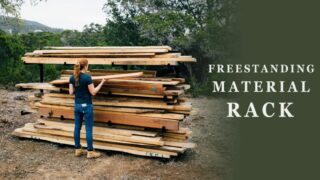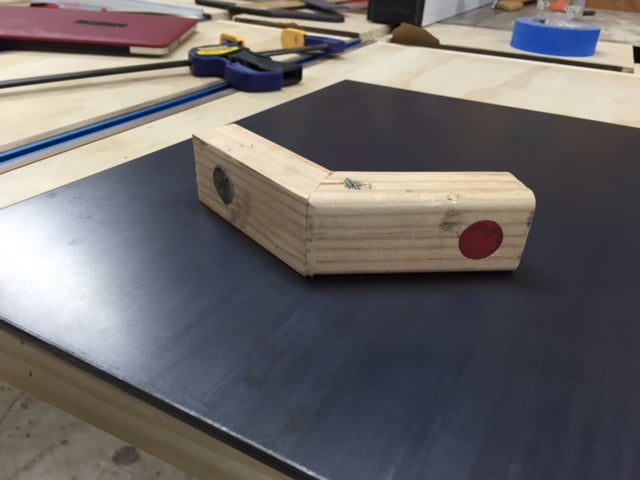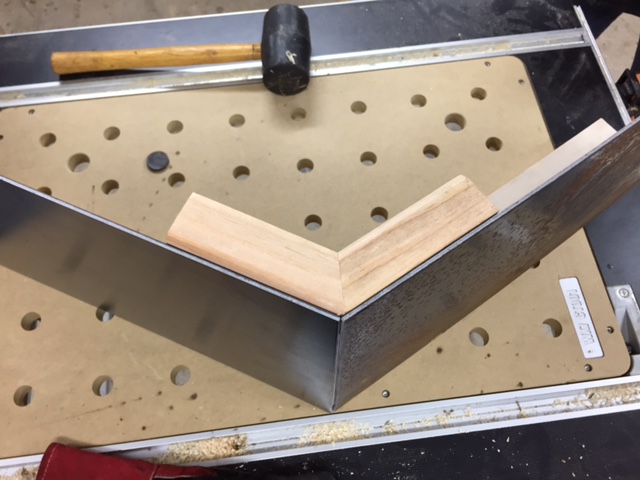
Making A Large Custom Steel Fire Pit
- Metal DIY Projects
- April Wilkerson
- Updated: March 5, 2023
Thinking about building your own custom steel fire pit? Check out this cool DIY project where I built my own fire pit for my backyard!
I cant stand our current fire pit. I mean, it’s ok….but I didn’t make it and it’s also too small for the amount of wood we burn when we start a fire so I would really like to build one myself. This week I am going to do just that. I have been itching for another steel project and some under the hood time with this welder and plasma cutter of mine. I think that a custom outdoor fire pit is the perfect fit for the job. After browsing the internet and shamelessly looking at other designs for inspiration, I decided on a simple hexagon shaped fire pit made from steel plate and some sturdy steel feet. Lets get it done…
I recently visited Matt Cremona up in Minnesota and had the chance to drop into a place know as “discount Steel”. It just so happens we have a location in my neck of the woods and they have a huge selection of different material. Once I got there to pick up my material, I felt like a kid in a candy store They have everything from large plate steel all the way down to little 1$ right angle gussets. Stocking stuffers anyone??
Drafting Kit
Discount Steel
Revmarker
Welding Gloves
Welding Hood
Plasma Cutter
Welding Cart
Angle Grinder
Magnets
Triton Work Center
Dark Safety Glasses
Large Compass
I called in an order for the steel and had the side and bottom pieces cut to the size that I needed. I used 14 gauge steel for the sides that make up the body and 10 gauge plate for the bottom. After getting the steel to the house I started making a cut pattern for the sides. I went with a geometric pattern but you can get really creative with this and do whatever you are personally into.
I kept it simple and used some generic drafting tools to draw up the pattern of diamond shapes. After drawing the pattern on the first piece of steel I went straight to cutting it out…..big mistake. Unfortunately, the steel began to warp slightly due to all of the heat from the plasma cutter. So I decided to change directions.
I switched gears and started welding the body portion all together with the plates and then cut the pattern after the hexagonal body is built and attached to the bottom. This will give the plates a lot more rigidity when the pattern is cut away and warping should not be an issue.
After beating and pounding on the first plate to get it back to nice and straight, I attached it to another plate with the help of a jig. I made a couple of jigs to hold the plates 120° apart from one another and make joining these together easier. The first one was for the bottom and it was made from scrap 1″x2″ material. I cut the ends at a 30 degree angle then used two pocket holes to attach them together. This jig could rest on my work surface then I could slide my two pieces up against it. To handle the top was harder since there is no work surface to support a jig, so instead I made a smaller version of the 30 degreed cut jig but this time used a forstner bit to countersink to magnets on either end. This way I could place the jig at the top and my two plates were held in place for me to tack together.


Note: If you are working with straight stock like I am and need to make a 120° wooden jig, simply cut two pieces of material at 30° using something like a miter saw. You can join the 30° ends together with pocket holes or toe-nailed screws. Remember: (30° + 30° = 60°) and (180° – 60° = 120°). This is the measure of the inside angle of the hexagon shape I’m building…..and all others for that matter : )
I positioned the first two pieces of material together with the two jigs I made. Instead of going with a butt joint, I used what is called an open corner joint. This joint does a little bit better job at holding two plates together than a typical (single sided) butt joint.
At this point, I am only tacking the material together. After repeating this process for the remaining pieces I completed the hexagon shape. With all of the pieces tacked together, I went back and completely welding all of the joints.
Rather than weld one full seam at once, I would spread out the welds and only weld a small amount on each joint at one time. This helps keep the material from distorting and changing shapes on you. So I would weld a small length along the top, then stop and do the same to the bottom of the same joint. Then I would move to the next joint and repeat. Once I went fully around the body I came back and completed the weld in between the top and bottom to seal it completely.
As I mentioned above, the bottom is made from 10 gauge steel and the top is made from 14 gauge. The bottom piece is by far the heaviest out of everything. To cut the bottom, I laid the top hex on the bottom plate and traced out the inside shape onto the bottom. This trace line will be my cut line for the plasma cutter but since I traced the inside of the shape and I am wanting this bottom to fit snuggly in the body, I made sure to make my cut on the outside of the line. Once you trace the bottom onto the bottom make a mark on both the body and the bottom so you can realign them again later in the same orientation.
Tip: as I said before I had my steel place cut this bottom plate to size for me. I did this so I wouldn’t have to haul home a bigger sheet than needed. I would recommend asking your steel place if they offer the same service. I knew I wanted my fire pit to be 30″ across (from flat side to flat side) so I had my guys cut the plate at 30″ x 40″.
I used the plasma cutter to cut the hexagonal shape out of the plate. Since it’s thicker material I had to slow down my cut rate a lot and also turn up the current. Be mindful of your feet! These cut offs are heavy and will break toes without blinking an eye if they get ya. I always try and hold onto the cut off so it doesn’t fall off.
The fit was pretty snug but it took the help of a hammer for the body to go on around the bottom. I made the bottom edge of the top piece flush to the bottom face of the baseplate. Once it was in position I moved to the inside to weld the top to the bottom.
I did the same here as I did before when making the top and spread the welds out so that I did not dump too much heat into the plates at one time. This may have been unnecessary but I figured I would be safer than sorry.
When I was done, the inside corner joint of the top and bottom plate was completely seal welded. At this point my fire pit was beginning to take shape and actually look like something.
Now it was time to focus on cutting in the pattern to the three sides of the fire pit. My original plan was to cut one side then use it as a stencil, however since I had a change in plans and that was no longer an option I went ahead and made a stencil out of quarter inch wood instead of drawing the pattern on each individual side. I use the same pattern as before cut the pattern out with a jig saw, and then traced the pattern onto the remaining sides that I wanted to cut.
Note: I first started this project using a red sharpie. A good friend of mine stopped by and gave me a silver sharpie which is intended for writing on metal. It worked much better when looking through dark safety glasses and using the plasma cutter.
Tip: I find it best to pull the cutting torch toward your body as you make straight cuts. Pushing the plasma torch makes it more difficult to keep a nice clean cut line. If you are not comfortable “free handing” cut lines or absolute straightness is a concern, a nice straight edge will do the job. I personally prefer either a piece of flat bar or a large framing square.
I came back for a little bit of post-process grinding to clean up all of the edges from the plasma cutter and while I had the right angle grinder out, I also cleaned up the the welds on the side joints.
After all of the edges were cleaned up, I focused on adding some small drain holes to the bottom so that the fire pit does not hold water. With the fire pit upside down, I traced out a simple pattern for the drain holes by first using a compass to draw two circles, then coming back with a roll of electrical tape so that I could trace the inside diameter.
I don’t even know if this next step is necessary but I wasn’t sure if these drain holes were large enough for embers to fall through or not so I decided to use some expanded metal as a screen for the underside. I simply cut a large circular shape with a cut-off wheel to cover the entire drain-hole pattern. The expanded metal screen was then attached with small tack welds.
At this point I focused on making some legs to hold the fire pit up off of the ground. I used my current generic fire pit as a gauge for how high I wanted my fire pit. The legs are made from 1-1/4” square tubing with a 30° cut on each end….one end for welding the leg to the base and one end to weld on a small “foot”. This is just to give it more surface area so it doesn’t want to sink into the ground.
I used four of the diamonds cut outs (from making the sides) to make some small feet for the bottom of the legs. I simply cut a small diagonal off of each corner to create the octagon shaped foot and welded them to the leg material.
I attached the legs on a square pattern that was larger than the circular drain pattern. I made sure to weld the legs on so that they do not stick past the edge of the top.

After some clean up, the final step was to paint the entire fire pit with high temperature automotive paint. This paint is used for high temperature exhaust manifolds which see temperatures above 1500°. I am hoping this finish is strong enough to hold up on this fire pit so that corrosion does not set in. If it does, I suppose I will be forced to take the next step and send it to powder coating.






That pretty well completes this project. I had a lot of fun with it and though some portions were challenging, overall the project was pretty easy. As always, I managed to learn a lot during this build and look forward to adding some additional features in the future. I am considering a small grill section that will rotate over the fire so that I can cook meat and vegetables on it and maybe some type of “trim” such as small square tubing around the very top edge. For now, I’m going to turn my attention toward building a nice sitting area in the back yard to place this fire pit for my family and I to sit around on cool evenings.
Thank you so much for taking the time to learn more about this build and supporting what I do. Have a great day and stop back by to have a look at the outdoor sitting area I’ll be releasing soon.
Cheers – April